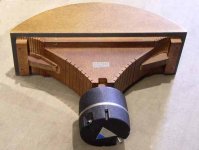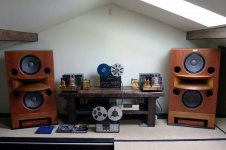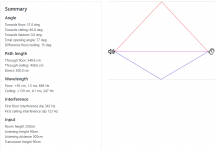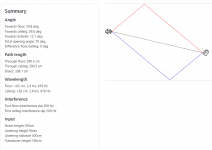On my large MTMs the sound does also seem to come from the horn alone.
Exactly.
After tasting some MTM honey, even with a horn-loaded dome tweeter, it's hard to go back to regular TM or TMM systems.
Some (potential) lobing and cancellation issues are dwarfed by the advantages of the vertical embedding of the mid/high section by woofers and the coupling with the room (at 70% of the floor-ceiling height).
Translated from Japanese:TD-4001 is rated from 600Hz-20k. How can this be x-over-ed at 425Hz?
"What is important here is the characteristics of Rey Audio's RH-3 wood horn. I don't think it has been open to the public in the past, but it is loaded up to almost 300Hz, and you can see that it is a very excellent design. Compared to the Pioneer (EXCLUSIVE) TH-4001 horn, the difference is that the low range around 300Hz is slightly extended, and both are excellent horns as they are reputed.
This 300Hz cutoff RH-3 wood horn is combined with the DEQX digital channel divider's rapid cutoff characteristic (96dB / oct) and the FIR filter with zero phase rotation characteristics to make full use of the RH-3 wood horn. It is the setting of our RM-6V that lowers the crossover to the low frequency limit of the horn load.
By setting the crossover as low as possible and expanding the band covered by the wood horn, most of the band for female vocals and trumpets are now reproduced by the horn.
Female vocals, which had been influenced by the high frequencies of the woofer and had a slight "nasal signature", have become even clearer, and the muted trumpet has become more realistic."
Attachments
Last edited:
whats "like that"?If you run the sub like that, anyone could find it...
Show it with the crossover engaged.
Last edited:
I should have said with a crossover that limits the response to the sub bass. What you showed before is why you can locate it, try a 24dB or steeper crossover at 80Hz or lower.
Many thanks. 96/oct... Now some things are becoming clearer. iirc the RH-3 has only a slightly larger mouth because of the flare but almost the same length as TH4001. So no big difference wrt loading. Both are excellent design but obviously the designers may have "overseen" that the fin arrangement is sub-optimal.Translated from Japanese:
View attachment 1020819
"What is important here is the characteristics of Rey Audio's RH-3 wood horn. I don't think it has been open to the public in the past, but it is loaded up to almost 300Hz, and you can see that it is a very excellent design. Compared to the Pioneer (EXCLUSIVE) TH-4001 horn, the difference is that the low range around 300Hz is slightly extended, and both are excellent horns as they are reputed.
This 300Hz cutoff RH-3 wood horn is combined with the DEQX digital channel divider's rapid cutoff characteristic (96dB / oct) and the FIR filter with zero phase rotation characteristics to make full use of the RH-3 wood horn. It is the setting of our RM-6V that lowers the crossover to the low frequency limit of the horn load.
By setting the crossover as low as possible and expanding the band covered by the wood horn, most of the band for female vocals and trumpets are now reproduced by the horn.
Female vocals, which had been influenced by the high frequencies of the woofer and had a slight "nasal signature", have become even clearer, and the muted trumpet has become more realistic."
Hi, can you talk more on this or where to find more info? Speaker height doesn't come up very often in the forums, especially vertical reflections in mind.Exactly.
After tasting some MTM honey, even with a horn-loaded dome tweeter, it's hard to go back to regular TM or TMM systems.
Some (potential) lobing and cancellation issues are dwarfed by the advantages of the vertical embedding of the mid/high section by woofers and the coupling with the room (at 70% of the floor-ceiling height).
By 70% do you mean that the speaker (tweeter) is about as far away from the ceiling than the listener is from the floor? In which case angle towards first specular reflection point on both floor and ceiling is maximized (equal) giving most attenuation towards both these first vertical reflections. Also delays for both these reflections would be about the same.
But the speaker is now quite high leaving the listener quite far vertical off-axis. Do you then tilt the speaker downwards towards listener? In which case the ceiling would be again at high off-axis angle and floor low, like if the speaker was around listening height, except the delays of reflections would still be different for this position than typical close to floor speaker height. How does it work out, why is this better than having the speaker lower at listener height? If it is then do you know why? because the delays through floor and ceiling are equal or something else?
Attachments
Last edited:
These are still quite common, even on brand new monitors from a respected manufacturer.Both are excellent design but obviously the designers may have "overseen" that the fin arrangement is sub-optimal.
Regards
Charles
If it is the goal to just copy an existing design without further investigations then this might be called as "still quite common".These are still quite common, even on brand new monitors from a respected manufacturer.
Regards
Charles
Considering the design goal of this horn, are you suggesting that the fins could be arranged better, or should they be removed altogether?the fin arrangement is sub-optimal
Ask a shark if he is able to navigate without his fin.Considering the design goal of this horn, are you suggesting that the fins could be arranged better, or should they be removed altogether?
That depends on the parameters of the horn but you can see the difference between some different fin arrangements here to get the ideaWhat would a better fin arrangement look like ?
https://www.diyaudio.com/community/...nd-bem-simulation-results.382115/post-6916987
Hi, can you talk more on this or where to find more info? Speaker height doesn't come up very often in the forums, especially vertical reflections in mind.
By 70% do you mean that the speaker (tweeter) is about as far away from the ceiling than the listener is from the floor? In which case angle towards first specular reflection point on both floor and ceiling is maximized (equal) giving most attenuation towards both these first vertical reflections. Also delays for both these reflections would be about the same.
But the speaker is now quite high leaving the listener quite far vertical off-axis. Do you then tilt the speaker downwards towards listener? In which case the ceiling would be again at high off-axis angle and floor low, like if the speaker was around listening height, except the delays of reflections would still be different for this position than typical close to floor speaker height. How does it work out, why is this better than having the speaker lower at listener height? If it is then do you know why? because the delays through floor and ceiling are equal or something else?
All true and such a solution is not without compromises (which loudspeaker concept is that?).
You lose some, but get a lot in return.
A sub-optimal example of an MTM-concept are the top models from Wilson Audio, because of the asymmetry in the vertical plane and the unnecessary complexity.
When complex solutions are applied to overcome certain acoustic phenomena, it's often at the expense of the reproduction quality.
The magic of an array-like setup is lost because the lower frequencies are only coupled to the floor and the mid/highs are not embedded symmetrically.
This solution is much simpler, 20x cheaper and makes more sense imho:
Last edited:
Ok. I thought Lean Business had them in stock. Perhaps Celestion isn't too interested in selling their very expensive Axi. Are there any similar horn alternatives that are less expensive than the two now defunct horns? Horns that are made for this driver? Other than the K402 that can only be bought with it's mated driver?Presumably, the LH9045R and LH6040R - that were specifically designed for the Axi, are no longer in production due to the high manufacturing costs and resulting high retail prices (£950 and £1050 apiece respectively).
It's an odd situation that there are so many compression drivers available, yet so few horns. The common excuse given - that people want to make there own horns - doesn't float for me.
It doesn't tell you how to get there though lol! It can be used to 300hz but you still gotta provide a driver that can play to 300hz lol!
I like the 20x less costly solution better. The mid/highs are embedded symmetrically where it counts most. But, I think it's reasonable to ask what low frequency crossover point is required to to achieve the magic of a D’Appolito array-like setup. 100Hz? 400Hz? 650Hz? Perhaps 1Khz?All true and such a solution is not without compromises (which loudspeaker concept is that?).
You lose some, but get a lot in return.
A sub-optimal example of an MTM-concept are the top models from Wilson Audio, because of the asymmetry in the vertical plane and the unnecessary complexity.
When complex solutions are applied to overcome certain acoustic phenomena, it's often at the expense of the reproduction quality.
The magic of an array-like setup is lost because the lower frequencies are only coupled to the floor and the mid/highs are not embedded symmetrically.
View attachment 1020879
This solution is much simpler, 20x cheaper and makes more sense imho:
View attachment 1020880
IMO, I'd say 650Hz is just fine for that low point, and can be accomplished with one compression driver and horn/waveguide. Some say 400Hz. I think one expert poster here would say 1Khz is fine. I have no argument with any, but it would be a good academic exercise to discover. I think there is a lot of wiggle room, depending on the application. Taste and money will rule.
I did build an MTM a few decades ago. Floor standing. Resistive vent. Used Dynaudio drivers. 17W75 woofers; and a D28 tweeter - the dome with the horn. They were very good. No low bass, but lot's of slam.
- Home
- Loudspeakers
- Multi-Way
- Is it possible to cover the whole spectrum, high SPL, low distortion with a 2-way?



